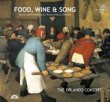- The Marriage at Cana by Gerard David, c. 1500; this detail shows the table-knives (and meat-carving technique), plates, cups, and salt-cellar
- Goblet, Murano, ca. 1500
- Glass flask with a portrait of Henry VIII of England, made in Venice ca. 1500
- Book of Hours used by Henry IV, 16th century
55v: While the sense of scale seems entirely out of whack in this picture (notice the impossibly small eating-knives, the tiny round trenchers, and the oddly-sized gilt serving bowls), this illustration does provide a nice detail of the pattern on the tablecloth.
- 16th century Italian gilt bronze presentoir
- Redware necked cup, Oxford, 16th century
- Glassware from 16th century Venice: three fancy glass drinking-vessels; a römer; goblet in white glass
- Plain tin-glazed pottery from Seville excavated in Exeter, dating to the early to mid 16th century.
- Salt-glazed stoneware vessels imported to England from Cologne in the early 16th century.
- Mazer, London, 1500-1525 (see also the mazers linkspage)
- Goblet with the arms of Liechtenberg, Bohemia, 1500-1530
- Midlands purpleware barrel-shaped jug, early - mid-16th century
- Stemmed and prunted goblet, Lower Rhineland, 1500-1550
- Prunted beaker, Lower Rhineland, 1500-1550
- Footed beaker, Germany, 1500-1550
- Prunted beaker, Germany, 16th century
- The Flower of Virtue, 16th century
The lovers, at an outdoor luncheon, eat from rectangular silver (or pewter?) trenchers; also on the table are round (breads?), a circular platter, a drinking vessel, and a covered saltcellar.
- Post-medieval pottery from London includes links to photos of jars, jugs, drinking-vessels, goblets, costrels, bowls, and porringers from 1501-1700.
- January, The Da Costa Hours (PML M.399, fol. 2v), 1515: Items on the table include a platter, a rectangular trencher, small round plates or bowls, a covered saltcellar, a beaker, and a candlestick. The color and materials for the items set on the table are difficult to discern; the room is not well-lit.
- Maiolica plate made in Venice, to commemorate the 1516 marriage of Hans Meuting and Dorothea Hörwarth (both from Augsburg families); see also the maiolica linkspages
- January, Die Augsburger Monatsbilder, 1520s: A dinner in featuring many dishes and a grand display of pewterware (or silverware?) and glass drinking vessels. Note the butler pouring drinks, and another servant voiding a plate into an orts-pot. Games are being played elsewhere in the hall during mealtime.
- Last Supper, Andrea del Sarto, Florence, 1520-25
Easier to see in these details. Shallow bowls (colored green inside and out) and flat disc-like plates.
- A set table with two benches, The Tudor Pattern Book (Ashmole 1504, fol. 10v), c. 1520-1530
- Sherds from a Tuscan maiolica dish dating to 1520-1550, found in Exeter
- Supper at Emmaus, Jacopo Pontormo, 1525
A (pewter?) pitcher; a cylindrical glass beaker; a conical glass goblet; white-handled eating knives.
- Family Portrait, Maerten van Heemskerck, 1530
The father holds a conical glass goblet. An odd basket (with a raised center) holds fruit. There is a small square trencher (pewter? horn?] for each person at the table. Each grown-up has an eating knife. There are also a flagon and a footed dish, both nicely decorated, probably pewter.
- Supper at Emmaus, Jacopo Bassano, Rome, 1538
The main course is served from a pewter bowl at the center of the table; eating knives and a glass goblet are found elsewhere on the table. (Notice that the white linen tablecloth is on top of the more elaborate table carpet.)
- Maiolica plate (istoriato style) with a scene from the Battle of Cascina and the arms of Pietro Bembo, made in Urbino ca. 1539-47
- Last Supper, Jacopo Bassano, Rome, 1542
Again, it appears that the main course is served from a communal round pewter platter at the center of the table. A conical goblet, a pitcher/decanter, eating knives, and a napkin are also arrayed on the table.
- Items found on the Mary Rose (1545):
a wooden spoon,
wooden bowls,
a wooden tankard (also top view with lid open),
leather flasks & costrels
- The Fountain of Youth, Lucas Cranach the Elder, 1546
In this detail, the young people dine outdoors on a table with a white tablecloth; the dishes are all round (probably silver or pewter plates), and they have various styles of German glassware and goblets. One man holds an eating knife; another seems to be serving himself with a spoon.
- Glass tankard with silver-gilt mounts made in London ca. 1548-49
- Drinking mug, c. 1550; silver-gilt mounts (including lid inscribed "+THE TONGE THAT LIETH KILLETH THE SOULE", hinge, and dolphin-shaped thumbpiece) on a simple stoneware mug
- Gilded glass goblet made in Venice or Antwerp in the third quarter of the 16th century
- Covered glass humpen (tall, cylindrical drinking glass) with diamond-point engraving of a double-headed eagle, second half of the 16th century
- Netherlandish Household, Gillis Mostaert
There are several dishes visible, including a covered jug on the floor, a cup (or tyg) on the table, a few platters, some round treen trenchers, and some two-handled baskets (one on the table with foodstuffs).
- Last Supper, Pieter Aertsen, Amsterdam, 1560s
Several disk-like trenchers, and two larger bowls (for serving wafers and cheese), possibly glazed redware. Three thumbed-bottom jugs of various sizes. Two small silver conical beverage containers (about the right size for a shot glass).
- Peasants by the Hearth, Juan de Juanes, 1560s
A shallow pewter bowl-like platter; eating knives; a low footed saltcellar; a long-necked glass decanter.
- The Triumph of Death, Pieter Bruegel the Elder, 1562
A skull inside a bowl on a table; the bowl is on a round pewter platter. There's also an up-ended long conical class on the table.
- Pierre de Moucheron, Merchant of Middelburg and Antwerp, and his family, 1563
Round dishes, bowls, platters, and footed dishes appear to be pewter or silver; eating-knives in front of adult family members
- The Harvesters, Pieter Bruegel the Elder, 1565
The men and women enjoying their afternoon meal look like they are using treen bowls and spoons. Another man (walking up the path) is carrying what looks to be a larger redware jug.
- The Peasant Dance, Pieter Bruegel the Elder, 1568
Several examples of ceramic drinking vessels: cups, a mug, a beaker, and a thumbed-bottom jug on the table; a seated man holds a tyg. (All of them are various shades of brown and gray, and a slight shine; perhaps they had a clear glaze on the outside, or are salt-glazed stoneware?) See also Ceramics in Art: Bruegel and his Rheinisch Stoneware.
- Peasant Wedding, Pieter Bruegel the Elder, 1568
Bowls look to be treen, as is a trencher just slightly visible on the table (on which an eating knife rests), and the spoons that a few of the guests are using. A butler pours beer from a stoneware jug; a redware jug rests on the ground (and may contain another beverage, perhaps wine). Most jugs are the same general shape (round-bellied thumbed-bottom) but are varying shades of brown or grey. Two of the women guests hold (or are passing to their neighbors) a tall conical brown vessel.
- Fête at Bermondsey by Joris Hoefnagel, 1569
- A Frechen stoneware cup with Exeter silver-gilt mounts; the silver-gilt dates to 1580.
- The Beaneater, Annibale Carracci, 1580-90
treen spoon; bowl and pitcher are of simple maiolica-style ceramic; a round treen trencher; an eating knife; a wine glass.
- A copper goblet made in Nuremburg c. 1580-1600
- Maiolica portrait dish, probably from Haarlem, ca. 1583; see also the maiolica linkspages
- Stoneware tankard made in Cologne ca. 1520-1540, with silver-gilt mounts added in London in 1584
- Glass goblet with diamond-point engraving and enamel bands; goblet manufactured in Venice, and engraved in London in 1586
- Two silver sturzbecher of the Tetzel family, made in Nuremburg c. 1590
- Stoneware tankard with the arms of the Englandfahrer trading company of Hamburg, made in Siegburg around 1595
- Sir Henry Unton, 1597 (also visible at MAPE, the NPG, etc.)
Some of the diners have napkins over their shoulders, with a variety of dishes are on the table in front of them; a servant looks over silver dishes in the background. (See this detail for a better view.) There is a masque in the adjoining scene.
- The Partridge Cup, made in Nuremburg c. 1600; parcel-gilt silver with mother-of-pearl, rubies, and emeralds.
- Supper at Emmaus, Caravaggio, 1601
A pitcher (maiolica?); a round glass decanter; a conical goblet; a (ceramic? slipware?) bowl; a roast chicken served on a (slipware?) platter; fruit served in a small basket.
- The Servants Breakfast After The Wedding by Pieter Brueghel
|









